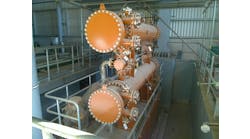Nearly every plant has them — equipment items abandoned in place. In better-documented facilities, such sidelined equipment still may appear on piping and instrumentation diagrams (P&IDs) with a notation like “OOS” (out of service) or “AIP” (abandoned in place). Equipment is left in place for two main reasons: money and uncertainty.
Money. Taking out equipment costs time and money. Removals often must occur during the same maintenance turnaround as routine activities and plant modifications. Disconnecting and hauling away equipment could extend a turnaround’s duration, which may increase costs even more than the direct cost of the removal.
However, many don’t realize that abandoning equipment in place usually isn’t free. It can add to costs by impeding operations and maintenance efforts and future projects. Removing sidelined equipment right away rather than waiting nearly always is cheaper.
Uncertainty. If the equipment still functions, the question often arises as to whether it might serve a useful purpose for something else in the future. Looking for potential savings or ways to avoid additional spending has become so ingrained in the minds of many managers and engineers that they are loathe to part with an asset out of concern they eventually will regret getting rid of it.
However, over the years I’ve found that equipment left in place usually rots due to lack of maintenance and rarely is used again.
So, if you’re working on a revamp or plant modification that will make equipment obsolete, frame the options by automatically acting as if the equipment will be removed. Include demolition P&IDs in the work scope as a matter of course, so removal becomes the default option. Ensure that any decisions to leave abandoned equipment in place are deliberate and only come after a full safety review.
Following such a decision, it’s essential to:
• Get rid of all process inventory. This includes liquids, solids and gases. Unsuspected accumulations of solids and liquids inside abandoned tanks and exchangers have caused many safety incidents.
• Remove all sludge, scale and corrosion deposits. These often contain residual process chemicals and can react in unexpected ways.
• Disconnect and purge all piping.
• Ensure no places are available for water to accumulate and potentially cause bursting due to freezing in cold climates or failure due to corrosion.
• Restrict personnel access to confined spaces to prevent inadvertent entry.
• Block, as required, animal and bird access.
Abandoned equipment inside an operating unit should remain on the P&IDs. The P&IDs should note the equipment is out-of-service and the date it was sidelined.
In addition, always consider hazards from abandoned equipment during scheduled safety and hazard reviews. These hazards may include:
• Obstruction — difficulty of access and egress around the equipment during regular maintenance, emergency escape, firefighting and other situations.
• Collapse — mechanical damage due to corrosion and failure of physical integrity.
• Oxygen — out-of-service equipment invariably gets exposed to air. Sometimes, equipment deliberately is left open to prevent formation of vapor products. In addition to causing corrosion, oxygen often catalyzes reactions. Even chemicals that react very slowly can create problems. Volume swelling from gradual polymerization of liquids has split open more than one exchanger. Such incidents can occur decades after the equipment is removed from service.
• Firefighting — empty equipment has no process fluid to remove heat. So, during a fire, abandoned equipment will heat rapidly. Mechanical failure can occur much sooner than in the surrounding in-service equipment. Collapsing equipment hampers firefighting and endangers personnel.
• Leaks — abandoned instrumentation conduits can provide paths for liquid and vapor to leak into unexpected locations. Underground conduit may carry materials hundreds of feet from a leak location. This has resulted in serious fires.
The best way to handle abandoned equipment is to remove it. Once you’ve taken it out, verify the equipment’s cleanliness and put some effort into preparing it for storage or get rid of it. If you want to keep the equipment, move it to a plant “boneyard” or spare equipment area.
Abandoning equipment inside an active process unit is rarely a good idea. It creates safety problems — for details on some specific incidents caused by sidelined equipment, see “Abandon-in-Place Must End,” http://goo.gl/6sL4kY — and usually costs more in the long run.



